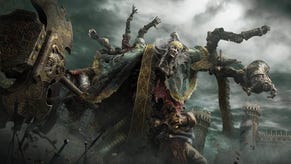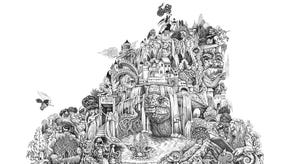The Elder Scrolls V: Skyrim
Cloud gaming.
Pretty much every openworld game presentation I have ever sat through has included the bit where the developer points to something on the horizon and remarks that you can actually go there. In the old days this used to be a unique and exciting possibility, but over the years the thrill has worn off. Nowadays we just nod politely.
Today Bethesda Game Studios game director Todd Howard is leading us on a magical mystery tour of the early sections of Skyrim, the fifth Elder Scrolls game. He is commenting on how his team ripped up a lot of the previous engine to accommodate the huge variations in scale.
Howard angles the first-person camera down at a flower and explains that stuff like this needs to look good. It does. Butterflies dance around the flower's detailed leaves as they sway gently in the spring breeze.
But stuff further away needs to look good too, Howard says. So he angles the camera upwards, past moss-covered boulders and away from the thick brush covering the ground, and settles on a mountain. Later we'll be told it's called The Throat of the World. One day you will go there, climb the 7000 steps to the top and meet the Grey Beards, who will teach you some more of the language of dragons.
However cynical I may have become, I can't look at this game without wanting to do just that. Skyrim makes adventuring feel exciting again.
Following a brief character-creation process, the game begins with you being led to your execution. You will get out of that somehow, although we don't find out how today. As with previous Elder Scrolls protagonists, no explanation is given for your plight. Instead you can decide what happened for yourself - if you're a good guy perhaps you'll decide you were innocent, and otherwise you can fill your imaginative boots.
Our first sight of Skyrim in action begins on a mountain path. It winds down past The Throat of the World and through a valley towards the small town of Riverwood, one of nine major locations in each of Skyrim's nine counties. (There are also five huge and iconic cities - expect more on those later in the year.)
Skyrim is a rugged place. The northern-most province in the Elder Scrolls world, it's home to the Nords, the original humans. It's also very beautiful. Throughout the demo I'm struck not just by the epic scale but the little details. Salmon leaping upstream. Cobwebs. A man positioning a chunk of wood on a chopping block, then bringing his axe down to split the wood into two distinct pieces, which he deposits in a basket.
Bethesda's games have sometimes been criticised for their awkward character models and arthritic animation, but that should be moot once Skyrim resets your expectations. Switching to third-person (you can play the game in first or third), it's immediately clear that the protagonist's movements hold their own against any other third-person adventure. All the NPCs do likewise. Argument over, hopefully.
All these evolutions are part of a larger push to make the world more convincing. This is really brought home during our experience in Riverwood, where we receive our instructions for the big mission that will be the centrepiece of Howard's presentation.
There's a big lumber mill nearby. A man is hefting large tree trunks into position to be cut down by the mill's mechanism. He puts his hands around the top-most bough on a pile, heaves it over his shoulders and drops it into a groove on the floor.
It's his job. I implicitly believe that before Howard even points out that the key to a believable environment is making sure people and creatures have roles that they perform, and that you can also perform, if you wish.
If you hang around you can watch the guy put the log through the mechanism. You can also sabotage the mill, which takes wood out of the local economy and makes arrows harder to come by. Howard says Bethesda is playing around with variables for this kind of behaviour.
A good benchmark for the quality of a game is how much you wish you were working on it when you sit through a preview presentation. Right about now, I wish I was in a room talking to designers about the ramifications of disrupting lumber production.
Another design challenge which must have been fun to solve is the interface. Forget the spreadsheets and clutter of the past, now you just hit the B button (we're on Xbox 360 today) to choose from Inventory, Magic, Map and Skills on a translucent overlay covering your in-game view.









